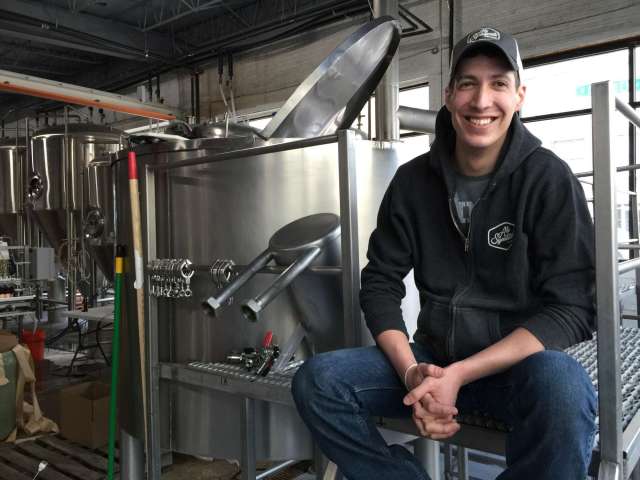The Makings Of A Maibock With Byron Moore Of Ale Syndicate
By Ben Kramer in Food on May 12, 2015 8:15PM

Photo via Byron Moore
In the world of brewing, the month of May is heralded by the maibock, a German lager.
A dark beer may seem odd to welcome in spring flowers but that’s the thing— It’s not dark. Unlike its darker cousin, the doppelbock, the Germans decided to cook up a bock that would be pale in color and have a recognizable hop presence.
To discuss the makings of a maibock, we consulted with Ale Syndicate Head Brewer, Byron Moore, who also provided us with his own recipe.
In our examination of the style, the first thing we needed to address were the malts. The malts give this beer its paleness and for Moore, it’s about using lighter malts. For this maibock he uses Pilsner malt as the base malt and Munich.
"I love Munich," he said, noting the flavor's toasty qualities. Remember, this is a malt-forward beer, so it’s gotta be malty. Moore describes Pilsner as a “neutral malt” so adding Munich supplies more maltiness and again provides toastiness. There’s a bit of wheat in his beer too, which gives some head retention along with more mouth feel.
When it comes to mashing his grains, Moore likes his temperature around 152 to 154 degrees Fahrenheit. Mashing at this heat will give the beer a nice body. Because you are working with only light grains, expect your beer to be slightly strong, around 6.5-7% ABV, which is within the Maibock's realm. This alcoholic effect comes from the grains, which are loaded with sugar that feeds the yeast for weeks. And speaking of yeast, Moore likes to use a southern German lager yeast because of its clean character, malty finish and low levels of sulfur and diacetyl.
Before adding the yeast, we can't forget the hops. Moore stuck with German hops, keeping things traditional. Magnum, Czech Saaz, GR Perle and Hallertau are incorporated to give a floral, softer component. Even though this bock is hoppier than most, it’s not an IPL. The purpose is to “compliment the malt instead of trying to stand out from it,” as Moore puts it.
As mentioned earlier, Moore uses a southern German lager yeast. He prefers to pitch double what you would with an ale because he wants to be sure there’s enough yeast cells in the wort. Why? To devour all those sugars, of course. After pitching, Moore starts his fermentation temperature in the mid 60s. As soon as he sees active fermentation (in his carboy) he drops the temperature gradually, to avoid "shocking" the yeast. That gradual drop happens over the course of the day, and gets him to 54 degrees, though you can ferment as low as 52 degrees.
From there, primary fermentation lasts between 7 and 10 days. Moore leans towards 10 because, “there’s always something going on in there,” meaning the yeast may still be active after a week.
Near the end of primary fermentation, Moore raises his temp to the low 60s so, "the yeast can have a chance to reabsorb any diacetyl that was created during fermentation.” Diacetyl is produced by the yeast, and can leave buttery or butterscotch flavors behind which the yeast can reabsorb during a "diaceytl rest." This rest lasts for two days towards the end of fermentation.
Following two days of diacetyl rest, Moore transfers to secondary to lager for 4 to 8 weeks at 34 degrees. According to Moore, you must ferment a lager for at least four weeks because lager yeasts initially produce unpleasant sulfurous compounds that take time to dissipate.
From there, if it’s in a keg, serve when you feel ready after 4 to 8 weeks. If you’re bottling, keep in bottles for 10-14 days at 54 to 60 degrees. Either way, when all is said and done, you’ll have a maibock to serve. Granted it’ll be after May, but why stick to guidelines?
Byron Moore's Maibock
All Grain
5 gallon batch
Boil Time 75 minutes
Target OG: 1.066-1.068
Target IBU: 20-35
70% Pilsner
20% Light Munich
10% Wheat
Mash at 152-154 for 60 Minutes
0.3 oz Magnum @ 60 min
0.5 oz Czech Saaz @ 30 min
0.5 oz Gr. Perle @ 10 min
0.5 oz Hallertau @ 10min
Primary Fermentation: 54 degrees for 7-10 days
Diacetyl rest @ 60 degrees for 2 days
Transfer to secondary, lager for 4-8 weeks @ 34 degrees
Bottle 10-14 days 54-60 degrees